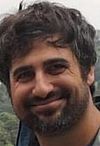Dr Ivor Simpson

Probabilistic statistical modelling of neuroimaging data for biomarker discovery
Discovering and quantifying neuroimaging biomarkers
Magnetic resonance imaging offers a powerful and flexible method to enable understanding of the human brain, and how it can be perturbed by disease. Biomarkers offer an approach to quantify characteristics and patterns from data that are associated with a condition or disease. Biomarkers can be used in downstream clinical tasks, such as diagnosis or prognosis, and if quantitative also contribute to neuroscientific understanding.
The overall aim of this PhD project is to build machine learning or statistical models that can discover and quantify sensitive biomarkers of brain anatomy or function. A key aspect will be to estimate the confidence with which these markers can be measured. Possible directions include:
-
Incorporating several MRI modalities (quantitative BOLD, ASL and structural) into machine learning models for quantification of brain metabolism. This extends recent work (in submission) by Dr Simpson, Dr Colosanti and Prof Cercignani.
-
Longitudinal modelling of multi-modal data in neurodegenerative diseases, which may include: structural, microstructural, functional and quantitative imaging, as well as genetic and cognitive testing. Specific challenges may involve identifying demographic bias, dealing with missing data and population heterogeneity, and embedding prior knowledge.
-
Investigating new strategies for morphometry (shape analysis), and particularly how to reduce the impact of irrelevant differences to enable more sensitive and discriminative measurements.
The latter two projects may focus on analysing pre-collected data from public datasets such as ADNI, HCP or UKBiobank. However, depending on interests there will also be opportunities to work on locally collected datasets from CISC, and in collaboration with other members of Sussex Neuroscience.
Towards diagnostic quality low-field MRI using machine learning
Low-field MRI, operating at magnetic fields two orders of magnitude lower than commercial clinical scanners, offers excellent potential for bringing cheap and effective MRI to regions and countries where MRI is scarce or unavailable. Low-field MRI systems pose much less risk to patients, have significantly fewer contraindications and require relatively few resources to build and run, enabling low-cost, accessible and sustainable imaging that could prove transformative for screening and point-of-care applications.
Existing systems have two major challenges compared to high-field MRI that prevent widespread adoption: lower contrast between different tissue types due to the low field strength; and substantially lower signal-to-noise ratio. These factors lead to noisy images where structural boundaries may be difficult to accurately discern.
This project, in collaboration with Itamar Ronen (Academic director of CISC), will address these challenges through the development of image analysis and machine learning tools with the aim of producing clinically useful images from low-field MRI. These models could be created using data from a combination of sources including:
-
Real “paired” high- and low-field brain images, which will require aligning and processing to reduce the impact of both high- and low-field artefacts in order to make them as comparable as possible.
-
Simulated datasets of the same tissue at multiple field strengths, where all the factors of variation are knowable. Building understanding from synthetic data is essential as we will only ever have small paired datasets,
-
Spatial and appearance information from existing large-scale MRI datasets and atlases.
General
These are computational projects, which would suit a student with reasonable mathematical and programming (ideally Python) skills and a keen interest in machine learning, as well as neuroimaging. There will be extensive opportunities to further develop these skills. An appropriate co-supervisor will be appointed based on the project collaborators and research interests. As well as participating within Sussex Neuroscience, students will also benefit from being part of the Predictive Analytics Lab: where there are regular reading groups devoted to understanding state-of-the-art computer vision and machine learning techniques across a wide variety of applications.
Key References
For low field MRI:
-
O’Reilly, Thomas, and Andrew G. Webb. "In vivo T1 and T2 relaxation time maps of brain tissue, skeletal muscle, and lipid measured in healthy volunteers at 50 mT." Magnetic Resonance in Medicine (2021).
For shape modelling:
-
Dorta, G., Vicente, S., Campbell, N.D. and Simpson, I.J., The GAN that warped: Semantic attribute editing with unpaired data. CVPR 2020,
-
Simpson, I.J., Cardoso, M.J., Modat, M., Cash, D.M., Woolrich, M.W., Andersson, J.L., Schnabel, J.A., Ourselin, S. and Alzheimer’s Disease Neuroimaging Initiative, Probabilistic non-linear registration with spatially adaptive regularisation. Medical image analysis, 2015
For uncertainty modelling:
-
Dorta G, Vicente S, Agapito L, Campbell ND, Simpson I. Structured uncertainty prediction networks. CVPR 2018
-
Simpson IJ, Woolrich MW, Andersson JR, Groves AR, Schnabel J. Ensemble learning incorporating uncertain registration. IEEE transactions on medical imaging. 2012
For a full list of publications, visit Ivor Simpson’s staff profile.